Rest In Peace, Tab. You Had Sass!
By Eric Grigs | October 19, 2020
The cola wars saw a major casualty this week. After a long 57-year run, Coca-Cola announced that due to challenges from the coronavirus pandemic, it will be ceasing production of Tab soda. The era of the pink can that helped popularize diet soda has come to an end.
Sales had been dwindling, but a dedicated base of drinkers (“TaBbies” or “TaBaholics”) kept the beverage alive and profitable over its waning years, though limited to a few major markets. I wouldn’t go so far as to call myself a Tabbie, but when every trip to the grocery store I found empty shelves where Tab should be stocked—along with a failed Instacart 12-pack delivery—I knew something was up. Then this week, the Wall Street Journal confirmed that COVID-19 supply chain disruptions hastened Tab’s demise.
Introduced in 1963, it was Coca-Cola’s first diet soda, intended to compete with RC’s popular Diet Rite. The marketing slogans and jingles the soda is best known for were developed after the word “TABB” was selected among the best of an IBM computer’s 185,000 randomly generated four-letter combinations for the new soft drink. Shortened to just one “B,” the can’s design made use of capitalization for the remaining one, so you’ll often see the name stylized as “TaB.” With catchy advertising, Tab quickly cornered the market as the preferred choice for a growing population of consumers concerned with healthy alternatives—particularly people who wanted “to keep tabs on their weight.”
Drinking Tab in the 70s and 80s seemed so cool—the ads were so peppy (and preppy)! “Tab’s got sass!” and “Tab’s for beautiful people!” they proclaimed, and I wanted to have sass and to be beautiful. Who didn’t yearn to fit into those slim neon Esprit shirts and stone-washed Jordache jeans advertised in the fall JC Penney catalog? I believed in Tab’s promise to help get me there. Even if that meant drinking some caramel-colored fizzy chemicals!
The sassy lineup of appearances in Tab ads included actress and supermodel Jayne Kennedy (pictured above), “Full House” star and college admissions scandal convict Lori Loughlin, former late night TV host Arsenio Hall, and Van Halen “Hot for Teacher” video vixen Donna Rupert, among others.
As quickly as the “just one calorie” soda caught on, so did the reputation of Tab’s infamous ingredients. Ditching sugar for artificial flavorings as sweetener, the first formulation used cyclamate and saccharin. When cyclamate became a known carcinogen and was banned by the FDA in 1969, Tab switched to sodium saccharin as its main sweetener. However, saccharin was soon also linked to cancer in lab animals and warning labels were required on the food products in which it was used. Strangely, this didn’t deter sales. The first significant sales dip came in 1984 when its recipe changed to NutraSweet, and many of Tab’s diehards abandoned the drink for its perceived change in taste.
For the record, I do love the taste, but I couldn’t really tell you if its crisp diet flavor of 2020 was all that different from the Tab I drank in the 80s. Those who mock the brand have stated its name meant “Tastes Awfully Bad.” (I swear, it wasn’t!) So if you’ve never had a Tab but wonder what you missed out on, just think back to the first time you ever had any diet beverage or tasted artificial sweetener. No one thinks it tastes like sugar. It’s altogether different; either you’re on board with your food and drink tasting less natural and more space-age—like a pill from the Jetsons—or you’re not.
Throughout its life, Tab’s formula was tinkered with much like every sweet carbonated beverage, resulting in all the variations you’d expect: flavored versions like Orange and Cherry Tab, as well as caffeine-free and clear ones. During the height of the 80s health craze which gave us aerobics and entire stores dedicated to selling vitamin supplements, celebrity spokesperson Margot Kidder endorsed the addition of calcium while promoting its uncanny power to shed pounds. But my favorite change was the most permanent one: the genius scientists at Coke at some point finally figured out how to get rid of that one last pesky calorie. So Tab’s modern formulation joined the other diet beverages—including its own intended replacement, Diet Coke in 1982—which had somehow outdone its “great one calorie taste.”
In retrospect, Tab had a longer life than many would have expected. The soft drink’s cult popularity helped it hold on strong for nearly six decades. Unfortunately, as with all we’ve lost this year, we’ll have to say a quiet goodbye to some of the things from the past we loved (and just buy bigger sweatpants). Tab is lovingly survived by its children Diet Coke, Diet Cherry Coke, and Coke Zero. Someone better check on Tahitian Treat and Mello Yello though; they may well be next year’s next victims.
Eric Grigs is a pop culture writer, artist, and co-host of the Pop Trash Podcast.


